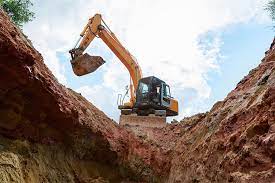Unveiling the Depths: A Comprehensive Guide to the Trenching Process
Introduction
In the vast landscape of construction and infrastructure development, trenching stands as a foundational process, carving the way for utility installations, pipeline placements, and other critical undertakings. Trenching involves the excavation of long, narrow channels into the earth, revealing a hidden world beneath the surface. In this blog post, we’ll delve into the significance of trenching, the various applications it serves, and the meticulous process that transforms the earth beneath our feet. For a free quote on trenching and excavating services in Knoxville TN, contact us today!
Understanding Trenching
What is Trenching? Trenching is the process of digging deep and narrow channels into the ground, creating a trench. This method is employed for a variety of purposes, including laying utility lines (such as water, gas, or electricity), installing pipelines, and facilitating the groundwork for foundations and drainage systems. Trenches can vary in depth and width based on the specific requirements of the project.

The Importance of Trenching:
Utility Installations: Trenching is essential for laying underground utility lines, ensuring a secure and concealed passage for essential services like water, gas, and electricity.
Pipelines and Conduits: The process is crucial for the installation of pipelines and conduits, allowing for the transport of liquids, gases, or communication cables beneath the surface.
Foundation Preparation: Trenching is often part of the groundwork for building foundations. It provides a designated space for foundational elements and utilities required for the structure.
Drainage Systems: Trenching plays a vital role in creating effective drainage systems, preventing water accumulation and potential damage to structures.
The Trenching Process Unveiled
1. Planning and Design: The trenching process begins with meticulous planning and design. Engineers and project planners assess the site, considering factors such as soil composition, existing utilities, and the intended purpose of the trench. The design phase includes determining the trench’s depth, width, and alignment.
2. Marking and Layout: Once the design is established, the site is marked to outline the trench’s dimensions and alignment. Precision is crucial at this stage to ensure the trench aligns with the project’s specifications.
3. Equipment Selection: Trenching requires specialized equipment tailored to the specific needs of the project. The choice of equipment depends on factors such as soil type, trench depth, and the presence of any obstacles. Common equipment includes trenchers, excavators, and backhoes.
4. Excavation: The heart of the trenching process is excavation. Heavy machinery is used to dig into the ground and create the trench according to the marked layout. The soil removed during excavation is typically placed beside the trench for later use.
5. Shoring and Sloping: Depending on the soil type and trench depth, shoring or sloping may be necessary to prevent collapses. Shoring involves installing support structures like braces, while sloping entails creating angled sides to stabilize the trench.
6. Spoil Management: The soil removed during excavation, known as spoil, is managed carefully. It may be stockpiled for later use or transported off-site, depending on project requirements and environmental considerations.
7. Installation of Utilities or Pipelines: After the trench is excavated and stabilized, the designated utilities or pipelines are installed. This phase demands precision to ensure proper alignment and connection of the underground infrastructure.
8. Backfilling: Once the utilities are in place, the trench is backfilled with the excavated soil. This process involves carefully layering the soil to cover the utilities and restore the ground to its original or desired level.
9. Compaction: After backfilling, the soil is compacted to eliminate voids and ensure stability. Compaction is crucial for preventing settling or shifting of the ground over time.
10. Surface Restoration: The final step involves surface restoration. Any disturbed areas, such as sidewalks or landscaping, are carefully restored to their original condition or improved as needed.
Choosing the Right Professionals for Trenching
The success of a trenching project relies heavily on the expertise of the professionals involved. Here are key reasons to entrust trenching to experienced contractors:
Technical Expertise: Experienced trenching professionals possess the technical know-how to assess the site, plan the trenching process, and execute the project with precision.
Equipment and Technology: Established contractors invest in advanced equipment and technology, ensuring that the trenching process is efficient, accurate, and aligned with industry standards.
Safety Measures: Trenching comes with inherent risks, including cave-ins. Experienced professionals prioritize safety, implementing measures such as shoring and sloping to mitigate risks to workers and the project.
Regulatory Compliance: Seasoned contractors are well-versed in local regulations and safety standards. They ensure that the trenching work complies with all relevant codes and permits.
Conclusion
Trenching may happen beneath our notice, but its impact is significant and far-reaching. Whether laying the groundwork for utilities, pipelines, or building foundations, the trenching process shapes the invisible infrastructure that supports our daily lives.
As you embark on your next construction or infrastructure project, consider the critical role of trenching. By engaging the expertise of seasoned professionals, you not only ensure the success of your project but also contribute to the seamless integration of vital infrastructure beneath the surface.